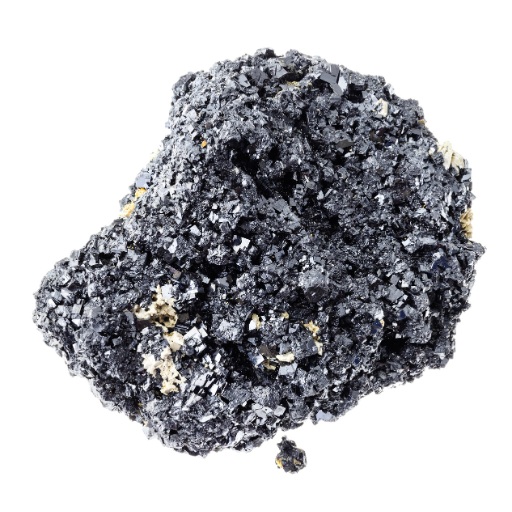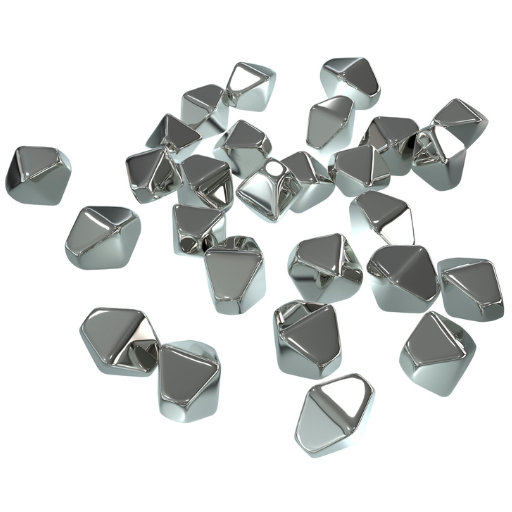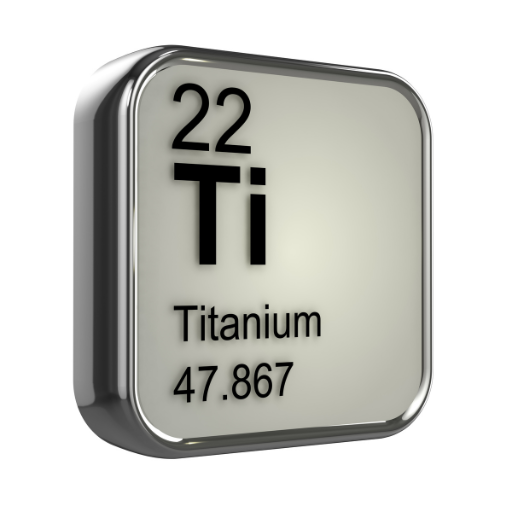What is the Density of Titanium?

Density refers to mass per unit volume. It is defined as the mass of a substance occupying one unit volume of that substance. The density of titanium, which is approximately 4.50 g cm^−3, is significantly lower than most metals like steel (7.8 g cm^−3) and aluminum (2.7 g cm^−3), but it has high strength that makes it ideal for use in both light weight applications and those that require durability.
Why is Density of Titanium is 4.50 Significant?
Titanium’s density around 4.5 grams per cubic centimeter holds high significance due to its optimal tradeoff between lightweight properties and high strength; this low density means that several application areas like aerospace, automotive and medical implants can be served where excellent performance as well as fuel efficiency can be achieved by reducing weights . In addition, this unique property along with its biocompatibility and corrosion resistance make the metal highly desirable for long-lasting uses in different harsh environments.
How is the Density of Titanium Measured?
What Does 4.50 Mean in Terms of Density?
How Does Titanium Compare to Other Materials?

Comparison with Pure Titanium
Several differences can be realized between titanium alloys and pure titanium. Commercially pure (CP) titanium, commonly known as pure titanium is recognized for its excellent corrosion resistance as well as biocompatibility and it is often used in medical implants and marine applications. However, pure titanium is comparatively soft and has lower strength compared to its alloyed equivalents.
On the other hand, Titanium alloys are treated with other elements such as aluminum or vanadium so as to enhance their mechanical properties. For example the famous Ti-6Al-4V alloy has much better tensile strength and hardness than commercially pure titanium thus making it preferable for aerospace and high performance engineering industries. Besides, Titanium alloys have good corrosion resistance but not like CP Titanium. Thus, while pure titanium excels in environments requiring high corrosion resistance and biocompatibility, titanium alloys are favored for applications demanding greater strength and durability.
Understanding Alloys and Low Density
The mixture of metals in alloys, as they are often called, usually incorporates elements to improve the features. An example is titanium alloy which combines with aluminum or vanadium among others to enhance its strength, durability and resilience to harsh conditions. The low density of titanium alloys makes them ideal for applications requiring high strength-to-weight ratios. This property is important in aerospace industry where weight reduction without affecting performance is necessary.
Titanium alloys are desired due to their low densities because they save on fuel consumption in airplanes and vehicles, reduce load in structural application and improve maneuverability and speed. The combination of better mechanical properties and lower density make titanium alloys better suited for applications that require both strength and lightweight characteristics. This delicate balance ensures that titanium alloys remain a preferred choice in many areas demanding performance under challenging circumstances.
Titanium vs. Titanium Alloy
Comparing titanium with titanium alloys involves understanding its distinct features and their optimal applications. Commercially pure titanium (CP Titanium) is highly biocompatible and has excellent corrosion resistance, making it ideal for medical implants and other applications in which the environment may be exposed to harsh chemicals or seawater. Nonetheless, it is generally weaker in comparison to its alloyed compounds.
Titanium alloys are made by combining titanium with other elements like aluminum and vanadium to enhance strength, endurance, and performance under extreme conditions. These materials exhibit moderate corrosion resistance but offer outstanding strength-to-weight ratio; hence why they are more preferred for high stress applications such as aerospace, military, and high-performance automotive engineering.
In conclusion, when the objective of an application takes priority over biocompatibility and resistance to corrosion then Pure Titanium would be the best option. On the other hand, Titanium alloys would be chosen for industrial purposes needing high strength and durability. Both materials have unique advantages that target specific needs across different sectors.
What are the Applications of Titanium Because of its Density?

Use of Titanium Metal in Industry
Role in Chemical Elements
Impact of High Strength and Low Density
Where is Titanium Found?

Titanium is mainly found on the Earth’s crust, frequently inside minerals like ilmenite and rutile. Major titanium deposits are located in countries such as Australia, South Africa, and Canada. These minerals are usually obtained from sands along beaches or from hard rock deposits. Mining of titanium-rich minerals is followed by a complex purification process to produce pure titanium.
Occurrence in the Periodic Table
Titanium belongs to Group 4 and Period 4 of the periodic table which makes it to be one among transition metals. It has an atomic number of twenty two (22) and Ti as its symbol. Due to being a transition metal, Titanium portrays properties like high melting points, existence in several oxidation numbers plus capacity to form complex compounds. Between Scandium (Sc) and Vanadium (V), Titanium’s position on the periodic table is represented by a delicate balance between lightness and strength thus constituting one important element for multiple advanced applications.
Discovering Isotopes and Atomic Mass
Titanium has five stable isotopes: \(^{46}\)Ti, \(^{47}\)Ti, \(^{48}\)Ti, \(^{49}\)Ti, and \(^{50}\)Ti with \(^{48}\)Ti being most abundant accounting for about 73.8% natural titanium. The slight variations in neutrons number among these isotopes accounts for differences in atomic mass. The atomic mass of titanium is approximately 47.867 u (unified atomic mass units). This value arises from taking weighted average masses of its isotopes according to their abundance in nature. Understanding these isotopes via researches enable precise material properties’ application such as medical diagnostics, advanced engineering or scientific research.
Naturally Occurring Oxide and Ilmenite
One common oxide derived from titanium is titanium dioxide (TiO\(_2\)). Rutile which occurs naturally in several crystalline forms alongside anatase, and brookite is the most common. Rutile is the most stable and abundant form found naturally while there are few occurrences of anatase and brookite.
Ilmenite is a major titanium ore composed largely of iron titanium oxide (FeTiO\(_3\)). Ilmenite normally appears as a black or brownish-black mineral being the main source of titanium in industrial applications. Heavy mineral sands are typically mined for ilmenite that is processed to generate both titanium dioxide and other compounds of titanium. In many cases, this refining process includes separation from other minerals then reducing it into more refined forms like synthetic rutile or titanium slag resulting in materials serving applications ranging from pigments to aerospace engineering.
How is the Density of Titanium Influenced by its Properties?

The atomic structure and bonding characteristics of titanium are largely responsible for its density, which stands at approximately 4.5g/cm3. The density of titanium is due to the hcp (hexagonal close-packed) crystal lattice in the low-temperature alpha phase and bcc (body-centered cubic) structure in the higher-temperature beta phase. These crystal structures added to by its relatively low atomic mass make it light but strong. Furthermore, slight changes in its composition caused by alloying elements or impurities slightly alter this all-important measure thus making it suitable for aerospace applications, medical implants and other high performance materials.
The Role of Body-Centered Cubic Structure
The body-centered cubic (bcc) structure is one of the most important determinants of its mechanical properties and performance especially during Ti’s beta phase at elevated temperatures. In comparison with HCP α-phase, BCC allows movement of atoms from one location to another increasing ductility. This makes it more convenient for usage in fabrication processes like forging and extrusion which are done on hot metal that has to be softened before bending or shaping into desired form. Moreover, this bcc structure contributes to an ability of alloys based on titanium to withstand higher temperatures without loss of strength while being used in such industries as aerospace engineering. Also, there is a transition between these two states which modifies the stability of phases or mechanical behavior causing them extremely efficient.
Effects of Atomic Mass and Transition Metal Characteristics
Titanium’s atomic mass together with its features as a transition metal significantly affect both its productivity and variability within various applications. As such, depending on the type employed, titanium alloys can have different chemical compositions ranging from 44-56 atomic mass units per atom; this range allows them to provide lightweight structures having good strength-to-weight ratios useful for aerospace sector as well as car manufacturing industry among others. Another characteristic feature inherent to transition metals is that they possess so called “variable oxidation states”, which are multiple values enabling a metal to play in different chemical processes and resist corrosion. In addition, transition metals like titanium have unique abilities of forming complex crystal structures that can be fine-tuned for specific mechanical or thermal properties . This flexibility has resulted in the wide range of applications for such materials including high strength alloys and medical devices.
Importance of Titanium Alloys
Reference sources
- Wikipedia – Titanium
- Source: Wikipedia – Titanium
- Summary: This Wikipedia article provides comprehensive information on titanium, including details about its density (4.502 g/cm3), properties, and uses. The article covers a wide range of aspects related to titanium, making it a valuable source for understanding the density of this element.
- WebElements Periodic Table
- Source: WebElements Periodic Table – Titanium
- Summary: The WebElements Periodic Table offers detailed physical properties of titanium, including its density of solid form (4507 kg m-3) and other relevant data. This academic source is useful for those seeking in-depth scientific information about the density of titanium.
- Roy Mech – Properties of Titanium
- Source: Properties of Titanium – Roy Mech
- Summary: Roy Mech’s article on the properties of titanium compares the density of titanium (4540 kg/m3) with other metals like steel and aluminum. It provides a practical perspective on the density of titanium, making it a relevant and informative source for individuals interested in understanding the comparative densities of different materials.
Frequently Asked Questions (FAQs)
Q: What factors influence the mass of titanium in different applications?
A: The mass of titanium in different applications is influenced by its density, often calculated using weight to volume or volume to weight conversion. Understanding titanium density is key, as it determines the mass per unit volume, making titanium useful in various industries for its lightweight and high strength properties.
Q: How is the titanium tetrachloride used in the preparation of pure titanium?
A: Titanium tetrachloride (TiCl4) is used in the Kroll process to produce pure metallic titanium. In this process, TiCl4 is reduced by magnesium in an argon atmosphere to yield pure titanium metal.
Q: What is the significance of the discovery year 1791 for titanium?
A: Titanium was first discovered in 1791 by a clergyman and amateur mineralogist named William Gregor. This discovery laid the foundation for further studies and applications of titanium in different fields.
Q: What role does titanium chloride play in titanium chemistry?
A: Titanium chloride, particularly titanium tetrachloride, is crucial in the extraction and refining processes of titanium. It is involved in the production of pure titanium through chemical reactions and reductions.
Q: How do the properties of titanium make it a preferred material in certain industries?
A: Titanium is a chemical element that is highly valued in various industries due to its unique properties, such as high strength, low density, and resistance to corrosion and high temperatures. This makes it ideal for applications in aerospace, medical devices, and marine environments.
Q: Can you explain the concept of mass per unit volume when discussing the density of titanium?
A: Mass per unit volume, commonly known as density, is a key characteristic of titanium. It helps in determining how much titanium (mass) is contained in a specific volume. This is crucial for designing lightweight yet strong components in engineering and manufacturing.
Q: Who were the notable figures in the early study of titanium?
A: The two notable figures are William Gregor, who first discovered titanium in 1791, and Martin Heinrich Klaproth, who named the element titanium and furthered its study in the late 18th century.
Q: How are the atomic weights of titanium species relevant to its use in chemistry?
A: The atomic weights of various titanium species are crucial for understanding the element’s behavior in chemical reactions. This information helps in predicting the outcomes of titanium-based compounds and their potential applications in different fields.
Q: Why is the resistance of titanium important in practical applications?
A: Titanium is resistant to corrosion, water, and carbon dioxide, which makes it ideal for use in harsh environments. This resistance ensures prolonged durability and reliability of titanium components in aerospace, marine, and biomedical applications.
Q: What are some methods for converting the weight of titanium to volume and vice versa?
A: Converting the weight of titanium to volume and vice versa involves using its density value. For example, to find the volume from a known weight (lb of titanium), you divide the mass by the density. Conversely, multiplying the volume by the density gives you the mass of titanium.








